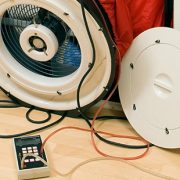One of the most commonly overlooked areas of your home is your ductwork. While you may stay on top of having your air conditioner and furnace maintained, your air ducts are just as important. Your ductwork is responsible for distributing treated air throughout your home. Clogged, leaky, or dirty air ducts may help spread dust, pollen, and other contaminants throughout your home and they can certainly contribute to rising energy bills.
Air duct cleaning is an important way to ensure your ductwork is in good condition and free of mold and other contaminants. While important, just keep in mind that duct cleaning has not been proven to prevent health issues related to indoor air quality and there has never been a study to conclusively show that particle levels in your home are increased due to dirty ductwork. This is because a great deal of debris in your ductwork adheres to the surfaces and isn’t guaranteed to enter your living space. With that being said, air duct cleaning can still serve as a preventative measure that doesn’t hurt your indoor air quality and may help your HVAC system work more efficiently.
What Is Air Duct Cleaning?
Air duct cleaning is a service that involves cleaning all of the components of your forced air system, including your heating and cooling elements. A qualified provider will use specialized tools to dislodge debris, dirt, and mold and vacuum these contaminants away. Chemical treatment may also be applied to your system to fight microbiological contaminants like mold and bacteria.
AIr duct cleaning may involve the cleaning of the following components of your HVAC system:
- Return and supply ductwork and registers
- Condensate drip or drain pans
- Air handling housing unit
- Fan motors
- Coils
- Heat exchangers
- Diffusers
Benefits of Cleaning Your Air Ducts
While there is no evidence that shows cleaning your ductwork can improve your health, many homeowners who have their ducts clean report feeling less congested and indoor air that smells fresher with less visible dust in the air. Regular maintenance of your ductwork is an important way to extend the life of your HVAC system, reduce your energy costs, and prevent humidity problems.
Potential benefits of air duct cleaning include:
- Fresher indoor air with less dust
- Prevents clogs due to debris and dust
- Prevents rodent and insect infestation
- Reduces the risk of serious and hidden mold growth
- Reduces strain on your HVAC system
- Keeps your air conditioner working efficiently to combat humidity and hot/cold spots
- Reduces your heating and cooling costs by finding and sealing air leaks
How Often Should Your Air Ducts Be Cleaned?
There is no specific schedule for duct cleaning but it may be a good idea to have your ductwork cleaned and inspected every year. This form of preventative maintenance may be needed more or less frequently depending on the age of your ductwork, the type of HVAC system you have, the air quality in your area, and your overall climate.
Along with having your ducts cleaned every 1-3 years, there are other steps you can take to prevent a build-up of dirt and contaminants in your ductwork:
- Change HVAC filters regularly. Depending on factors like your household size, how frequently your system is used, and whether you have pets, this may be every 1 to 6 weeks.
- Switch to high-efficiency filters.
- Vacuum the home regularly.
- Seal up your HVAC systems during construction or remodeling in your home until all debris and dust are cleaned up.
- Check for moisture on insulation near your cooling coils.
- Ensure your HVAC system is sized correctly for your home.
- Improve air circulation in your home by opening doors and windows when the weather allows.
Leaky Air Ducts and Energy Costs
Air duct cleaning isn’t enough to keep your ductwork in good shape; it’s also important to make sure it’s properly sealed. There are nearly 1 million miles of ductwork in homes in the United States. According to industry experts, about 2/3 of them leak enough that they should be repaired or sealed. Leaky air ducts can dramatically increase your heating and air conditioning costs, worsen indoor air quality, and put a great deal of strain on your HVAC system, shortening its life and reducing its performance.
According to some studies, up to 25% of your home’s total energy loss is attributed to leaks in your duct system. When there are leaks in your supply ductwork, for example, costly conditioned air can be sent into the attic, garage, or crawlspace instead of your home. Leaks in the return system pull outside air into the duct system and reduce the efficiency of the HVAC system and strain the system. If your ducts are leaking, it can prevent your HVAC system from doing its job, leaving some rooms too hot or too cold or leading to humidity problems. Leaking ducts may also pull contaminants into the home.
Routine air duct leak testing can detect any air leaks in your ductwork that allows conditioned air to escape or lets hot or cold air into the system from outdoors. Duct testing is a cost-effective way to make sure your HVAC system is able to work at peak efficiency. Duct leak testing doesn’t need to be often done, but it should be done every few years.
What to Expect During Air Duct Cleaning
Always choose an air duct cleaning company that’s licensed and insured. You can check customer reviews before selecting a company but be wary of hyped claims that duct cleaning has amazing health benefits as these claims can’t be backed by scientific evidence. During your appointment, your cleaner will probably perform an inspection and duct testing first and use specialized equipment. Your furnishings and flooring will be covered to prevent damage.


